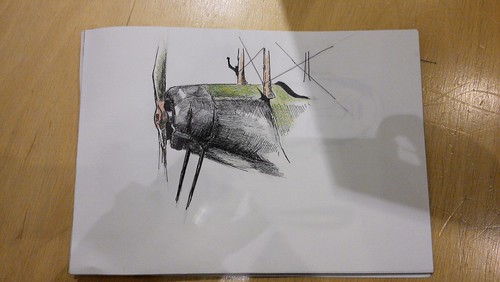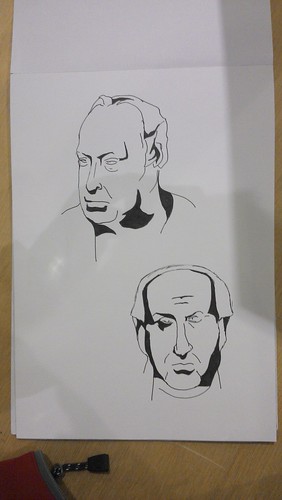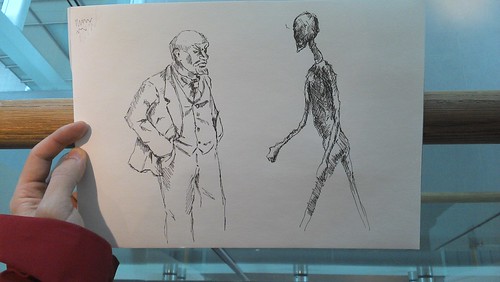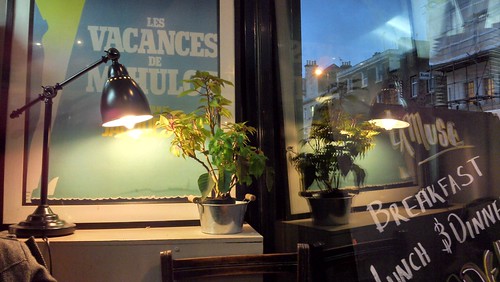Locus Sigilli
Yuriy Akopov's personal blog
Wednesday, April 23, 2014
Farewell locussigilli
Saturday, March 16, 2013
Saturday, March 2, 2013
Sunday, January 13, 2013
High Point Two
About a week ago I took a picture of a multi-storey block of flats in Highgate. Looking otherwise ordinary (well, "ordinary" for Highgate which is quite a nice area) it still was an instant eye catcher because of its caryatids (female figure pillars) supporting the entrance canopy:
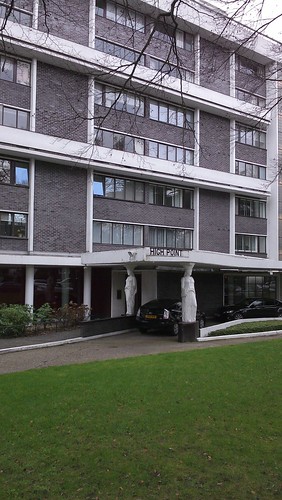
They looked so odd it must have been done of purpose, but I didn't bother to check until I received a comment on Flickr with a link to the story, and what I learned seemed exciting enough for a blog post.
The architect, Berthold Lubetkin, was actually a prominent modernist well-known in Britain (his architecture group was the first modernist one to be granted a public commission). Originally from Tbilisi, he left Soviet Russia in 1920s with his parents and got to London in 1931.
Despite the emigration Lubetkin retained "strong left-wing political allegiances". Developing as an architect outside of the USSR and Eastern Europe possibly saved his life (his parents residing in Warsaw died in Auschwitz during the war), but there was also something pathetic and also unfortunate about bearing his views and enjoying the fruits of the capitalist society. It was a bad timing - even when post-war Britain started to turn into a welfare state, it was also the beginning of the Cold War: one of earlier Lubetkin's housing projects named after Lenin was then renamed to Bevin Court after the anti-communist Labour Foreign Secretary. Desperate, Lubetkin buried a statue of Lenin removed from the entrance under the famous staircase.
Lubetkin's houses got quickly occupied by middle class residents rather than by workers who were supposed to be "liberated" by the modernist movement. Particularly the High Point II block a picture of which I snapped boasted too good location on a top of the hill even for then-smaller London, and his biggest work - a master-plan for miners' town Peterlee was rejected for being too complex and expensive (even for a constructivist project) for working class accommodations.
Soon he became disillusioned and retired relatively early in 1950.
Lubetkin's legacy is still celebrated - most of his work is protected by listing. There is also an annual Lubetkin Prize in architecture.
So sometimes taking pictures teaches you something new.
***
Back to Highgate, you can walk the area with a widget below:
View Larger Map
Saturday, December 1, 2012
Pics
Saturday, November 17, 2012
A case of assisted improvisation
The poetry course will be over in a day, so I decided to share my last essay I sent there a week ago.
The task was to write a "random" poem using the method of mesostic and an automated script, and then to do a close reading of it and to express thoughts on the technique used.
There were actually two tasks to choose from with the remaining one being playing with Bernadette Mayer's methods, but I made my decision very quickly for the reasons explained below.
***I can't resist starting with an explanation of my choice between the two options available for this assignment. It was easier for me than I expected to make this decision when I realised that despite its "technical" feel the "mesostic" method is actually not very different from some tactics we were already introduced to (Tristan Tzara's "How to make a Dadaist poem" being the most obvious example). This recurrence was the first thing to catch my eye and it didn't allow me to dismiss this option thoughtlessly as a curious but (at first glance) not deep enough experiment.
Then the fact John Cage was a composer and his idea of words being liberated from the "forced" meanings to become sort of as musical samples simply left me no other choice. Not being an English native speaker this is exactly how I used and sometimes still do perceive English lyrics in songs when vocals aren't very distinctive, and the strange thing is that it doesn't immediately make them dull or unworthy - they remain quite enjoyable, only in a different way. So due to my weakness I have a privilege to know for sure that the result I received from the automated script wasn't just a chaotic nonsense:
What
hAve
Looking
aT
Whole
families sHopping
aIsles
The avocados
aMong
refrigerAtor
eyeiNg
I chose WALT WHITMAN as a "spine" for my poem because from the very beginning of the course I was definitely more attracted to Whitmanian bunch. I believe by the way that this first step is very important in mesostic as it is the only part of the process which is entirely up to the creator. While pointing the script to source text is also a conscious decision, there is no control on what exactly would make it into the final poem. While you're free to choose between the undoubtedly different sources - different epochs, schools, genres, authors - it is still possible that the final difference would be next to none if the same words are picked out. Same words taken out of their natural context, much as fish taken out of the water, immediately become the same and lose the name of action.
So it is the "spine" that grants them a new life and essentially defines the new context – or more precisely, you do by choosing that "axis". The whole process of the creation packed in a single concentrated effort - when you accept this idea it suddenly becomes difficult to shout out a "random" name. What could've been easier than that before you became aware of the trick?
I used "A Supermarket in California" as a source because of its direct connection to the spine ("Where are we going, Walt Whitman?") It might be a wrong thing to abuse the randomness in that way but in my opinion it is justified by the created opportunity of receiving an answer to the questions asked in the poem.
I'm satisfied with the result which by the way was the first combination I received. If reviewed as a "foreign song" merely by how words sound it's proportionally weighted with the first shorter stanza composed of shorter words than the longer second one. It also starts with "what" which rhymes with "Walt" creating an intricate connection between the first horizontal and the first vertical words.
In the second stanza I like how the word "shopping" connects the two lines there, being shared between the "families shopping" and "shopping aisles", equally forming two meaningful combinations. There is also meta meaning in it as it is shopping as a process, not as a word, that leads people to aisles in real life.
The geometry of the poem is also nice: not too symmetrical but also not shaky with the counterpoising balanced beams of "families" and "avocados". Poem's "body" has a non-trivial shape resembling a comma, straight for most of its length but curving left at the end. Again an odd meta feeling here: with not a single comma in the whole poem it's still basically a list of independent words, each of them could be followed by one - so forming together a giant comma, they unexpectedly make sense.
But arguably the main purpose of any poem like this is to provoke thoughts on the context defined the spine phrase or name, to shed some light from an unusual angle and to admire the fanciful shadows it forms. Well, it did make me think of Walt Whitman, his poetry and his followers like Allen Ginsberg lost in the supermarket. It wasn't a single distinctive and clear idea, or I’d say not a problem which became clear to me. It was rather lots of unshaped thoughts and emotions, quick associations appearing instantly to burst into new ones like fireworks - bright, enjoyable and unstable.
Much like what I feel when I listen to music, only this time that was a music of "raw" words, instruments for which I have chosen for the band of the mesostic myself.
Wednesday, October 17, 2012
Back to school
I'm taking an American poetry course with Coursera the main part of which is writing essays. It's been quite a while since I did anything like that, and needless to say back in the day essays used to come in Russian, so my first results were as miserable as you could expect. They probably still are, but the last week's essay was finally the one I'm not that ashamed to share.
So the task was to compare two versions of William Carlos Williams's "Young Woman at a Window" (1, 2) and decide which one looks "more imagist" and why.
***
"The song sings itself"
According to a famous apocryphal story Michelangelo was once asked how did he know what to cut away. The response was, "It's simple. I just remove everything that doesn't look like David."
Much like Michelangelo's work, the second version of the poem looks like it was stripped of everything that wasn't very necessary to shape the idea. Pretty much everything representing a logical consequence of something already stated has been cut out. As a result, every new line of that version adds something new to the picture which did exist before instead of simply clarifying or detailing presented the previous stanzas. "Nor the merely decorative word".
This becomes clear when two versions are compared line by line. "She sits there" - where else can she sit? What changes if the woman sits "here" and not "there"? Sorry, but "there" has to leave. "While" - not needed, this poem is snapping a moment like a camera, so of course it's "while", no need to state it literally, goodbye and thank you.
Although these were the easy bits and it gets more complicated later. "The child who robs her knows nothing of his theft" - the whole point is gone in the second version, so this time it is not only about removing some obstructive words, this is a complete message being removed. That seems like an important edit yet it doesn't make a new poem, it stays under the same title - that probably means it's still the same and the cut wasn't damaging to the global idea.
This is where another imagism manifesto point comes to mind, particularly "to represent an image" one. From the image poem creates, reader is supposed to get the fact the child changes ("robs") woman's life of something on his or her own. Should it be stated directly, it'd give reader the idea straight away "robbing" them of their own impressions and intellectual work. Everything else in the poem would become nothing more than a frame for that literal statement rendering most of it once again unnecessary.
When the message is removed, all left is an image of a woman crying, holding a child who is interested in something else, "his nose pressed to the glass". He is not focused on the woman at the moment while she has him on her lap and obviously can't ignore him even being extremely disappointed. She is robbed by child having to care about him without receiving much back yet.
The same message is still delivered, only in a gentle way.
The manifesto also defines imagism as something "hard and clear, never blurred nor indefinite." This fits the vision again. While the reader is invited to make their own conclusions, the picture created by the second version of the poem remains crisp. All the major words are nouns with very particular meaning in a focused context: "cheer", "tears", "lap", "child", "nose", "glass". Metaforical interpretation is hardly possible here - the "woman" is the woman and the "child" is the kid, they aren't, say, Nature and Humanity, such a comparison seems very artificial and non-applicable.
Everything is kept simple and the image is clear.
Here is a woman in tears. Her child doesn't hear her.
